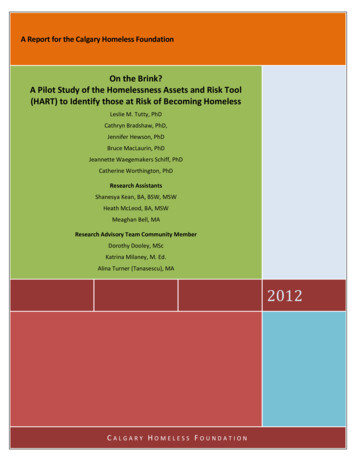
Transcription
A Report for the Calgary Homeless FoundationOn the Brink?A Pilot Study of the Homelessness Assets and Risk Tool(HART) to Identify those at Risk of Becoming HomelessLeslie M. Tutty, PhDCathryn Bradshaw, PhD,Jennifer Hewson, PhDBruce MacLaurin, PhDJeannette Waegemakers Schiff, PhDCatherine Worthington, PhDResearch AssistantsShanesya Kean, BA, BSW, MSWHeath McLeod, BA, MSWMeaghan Bell, MAResearch Advisory Team Community MemberDorothy Dooley, MScKatrina Milaney, M. Ed.Alina Turner (Tanasescu), MA2012CALGARY HOMELESS FOUNDATION
On the Brink?A Pilot Study of the Homelessness Assets and Risk Tool(HART) to Identify those at Risk of Becoming HomelessA Report for the Calgary Homeless FoundationByLeslie M. Tutty, PhDProfessor, Faculty of Social Work, University of CalgaryCo-investigators1Cathryn Bradshaw, PhD, Former Director,Centre for Social Work Research and Professional Development, Faculty of Social WorkJennifer Hewson, PhDAssistant Professor, Faculty of Social Work, University of CalgaryBruce MacLaurin, PhD Candidate (University of Toronto)Assistant Professor, Faculty of Social Work, University of CalgaryJeannette Waegemakers Schiff, PhDAssociate Professor, Faculty of Social Work, University of CalgaryCatherine Worthington, PhDAssociate Professor, School of Public Health and Social Policy, University of VictoriaResearch AssistantsShanesya Kean, BA, BSW, MSWMSW Student, Faculty of Social Work, University of CalgaryHeath McLeod, BA, MSWMSW Student, Faculty of Social Work, University of CalgaryMeaghan Bell, MACalgary Homeless FoundationResearch Advisory Team Community MembersDorothy Dooley, MScManager of Kerby Centre of Excellence, Kerby Centre, CalgaryKatrina Milaney, M. Ed., Calgary Homeless FoundationAlina Turner (Tanasescu), M. A., Calgary Homeless Foundation1In alphabetical order1
Table of ContentsTable of Contents . iiAcknowledgements . ivExecutive Summary . 1Methodology . 1Who Answered the HART? . 2Current Housing . 3Health and Mental Health Issues . 3Childhood Experiences . 4Ever Homeless by Core Demographic Characteristics . 5Responses to the ETHOS Scale . 5Rooflessness vs. At Risk vs. Never Homeless in the HART Pilot. 5The HART Follow-up. 6Discussion and Implications . 7Chapter 1: Introduction to the HART Scale . 10Defining Homelessness. 10The Faces of Canadian Homelessness . 12Who is Vulnerable to Homelessness?. 12Homelessness as Related to Structural Issues . 13Individual Factors Related to Homelessness . 14Chapter 2: Risk and Assets for Homelessness: Developing and Testing the HART . 16Structural Factors . 16Protective Factors . 18Individual Risk Factors . 19Childhood Factors . 19Current Interpersonal and Family Factors . 20Mental Health and Addictions . 21Health Issues . 22Housing Transitions . 22Homelessness Asset and Risk Screening Tool (HART) . 23Rationale for the Current Study . 24Methodology . 25The ETHOS classification system . 25Chapter 3: Results. 27Who Answered the HART? . 27Employment and Finances . 28Current Housing . 30Health and Mental Health Issues . 33Childhood Experiences . 34Individuals Not Currently Securely Housed when Answering the HART . 34Ever Homeless by Core Demographic Characteristics . 39Responses to the ETHOS Scale . 43Rooflessness vs. At Risk vs. Never Homeless in the HART Pilot. 44ii
The HART Follow-up. 50Discussion and Implications . 54Future Considerations . 56References . 58Appendix I: Risk & Asset Factors that Differentiate Homeless from At Risk of Homeless 67Appendix II: Annotated Homelessness Asset and Risk Screening Tool (HART) . 72Appendix III: ETHOS Categories and Definitions . 78Appendix IV: ETHOS questions added to the HART pilot . 80iii
AcknowledgementsThis research was funded by the Calgary Homeless Foundation and a CIHRInterdisciplinary Capacity Enhancement (ICE) Grant on Homelessness, Housing, and Health(obtained by Dr. Catherine Worthington and Bruce MacLaurin). Alina Turner (Tanasescu) andKatrina Milaney from the Calgary Homeless Foundation have contributed in a number of ways tothe success of this research project. Thanks to all.Thanks also to research assistants Meaghan Bell, Sylvia Barnowski, Gabrielle Daoust andDanielle Budgell who organized the original HART pilot data collection as well as conducting thefollow-up interviews.The Faculty of Social Work at the University of Calgary supported this project through itsCentre for Social Work Research and Professional Development.A community forum in 2010 sponsored by the Calgary Homeless Foundation and attendedby about 50 representatives from Calgary social service agencies, assisted in refining the HARTquestions and ensuring that the items reflected their clients’ circumstances. Thanks to all whoattended.Special thanks to the administrators and staff of the seven Calgary agencies thatcollaborated by “housing” the netbooks that provided internet access to the HART survey: Aspen Family ServicesNorth Central Community Resource CentreNorth of McKnight Community Resource CentreSunrise Community Link Resource CentreSouthWest Community Resource CentreWest Central Community Resource CentreYWCA of Calgary Sheriff King HomeFinally, many thanks to the 740 Calgarians who answered the HART. You havecontributed invaluable information to understanding risks and assets with respect to homelessness.Copies of the HART can be obtained from the principle investigator, Leslie Tutty, attutty@ucalgary.caiv
Executive SummaryHomelessness has become an all-too pervasive and visible problem in Canada. It hasspread from large urban centres to rural, northern and remote communities. While a number ofprograms have been developed to address the needs of the homeless in the hope of re-housingthem, a large population of those at risk of homelessness receive little attention until their needsbecome dire. There are both societal and individual costs to be borne when this occurs.Preventing homelessness has the potential to save countless individuals from the misery oflife on the streets. However, with the major effort focusing on assisting those that becomehomeless, where does one start to prevent this significant social ill? The few authors who havewritten about prevention provide no clear answers, but raise the importance of prevention as afocus (Burt, Pearson & Montgomery, 2007, US; Moses, Kresky-Wolf, Bassuk & Broundstein,2007, US; Wireman, 2007, US). One key question is how to define the population of those at riskof becoming homeless.The research team originally conducted a literature review summarizing research,particularly published studies from the past decade or so, that focus on the risk factors, predictorsand pathways in and out of homelessness (Tutty et al., 2009). Unpublished research reports fromreputable organization, especially Canadian ones, were also included. Our primary focus was onfactors that differentiate those that have become absolutely homeless from those that are on thecusp of homelessness, either being relatively homeless, or living in hidden homelessness. As such,the analysis focused particularly on studies that differentiated between these groups. We alsosearched for articles on resilience and protective factors, again finding relatively few.These assets and protective factors formed the core of a screening tool, The HomelessnessAssets and Risk Screening Tool (HART) that could be used to identify vulnerability tohomelessness in at-risk populations, but those not yet experiencing homelessness, in the hope ofproviding early interventions. The purpose of the current research is to test the validity of theHART, including its predictive validity with respect to identifying those at risk of homelessness.A second objective was to determine the applicability of the HART tool in a Calgarycontext and assess the tool’s feasibility from an administrative perspective. This was achieved byutilizing the HART tool with an initial sample of service recipients at multiple community agencieswithin the city of Calgary. This allowed us to test the tool’s content validity (the ability to captureelements of risk) by comparing responses to the HART to responses to the ETHOS (describedbelow) and to test the HART’s predictive validity (ability to predict homelessness) by tracking asub-sample of participants over a one-year period.MethodologyThe study participants were 740 adult residents of the Calgary area who presented at theparticipating Calgary agencies, primarily community resource agencies that provide assistance fora broad range of issues, homelessness being only one. Only those presenting for agency serviceswho were not currently homeless were invited to participate in the study (with the exception of asample of women from a women’s emergency shelter for domestic violence). Individuals whoagreed to participate were provided with a 25 honorarium.Following their completion of the survey instruments, the participants had the choice tostop or to continue to an electronic information sheet about Phase 2. If they choose to participate1
in Phase 2, they provided consent to be contacted at a later date as well as their contact informationand contact information for up to three additional individuals who would likely know of theirwhereabouts. Strategies to ensure confidentiality were addressed.The acronym “ETHOS” stands for the European Typology of Homelessness and HousingExclusion. This framework has been commonly used by member states in the European Union forreporting on homelessness and housing exclusion (European Federation of National AssociationsWorking with the Homeless, 2007). The classification system broadly categorizes the housingsituation of people who are absolutely homeless as “roofless” or “houseless.” ETHOS items wereincluded in the HART pilot to provide a more comprehensive idea of the extent to which the studyparticipants had experienced diverse forms of homelessness in the past ten years.Who Answered the HART?In total, 740 Calgarians answered the HART survey, although not all answered every itemon the measure. Seven Calgary agencies provided space and invited their clients to answer theHART. Most respondents specified at what agency they had completed the survey (720 of 740 or97.3%). Across the seven agencies, there was a relatively equal distribution of respondents (from8% to 18.8%).With respect to gender, almost two-thirds (63.9% or 458 of 717) respondents were womenand a little more than one-third were men (36.1% or 259 of 717). Regarding the age of therespondents, as anticipated, the largest proportion of those who completed the HART survey wasbetween the ages of 25 and 49. However, seniors are relatively well-represented with about onesixth of the total (16.2%) between the ages of age 50 and older. Youth are similarly representedwith almost 14 percent of the total sample.With respect to racial background, while almost half of the respondents were ofCauscasian/White background, another almost third were of Aborginal origins and a fifth werefrom visible minority groups. According to data from the 2006 Canadian census (City of Calgary,2012) , which was the last for which this information was collected, Aboriginal groups make upabout 2.4% of the Calgary population and visible minority groups about 22.2%. In the HART dataset, individuals of Aboriginal origins are over-represented in the current sample of those seekingassistance from community resource centres.About ten percent (69 of 707 or 9.8%) of the HART survey respondents had immigratedto Canada from a different country within the past five years. Of those, about half (30 of 69 or43.5%) came as refugees. In the 2006 Canadian census, 23% of Calgarians identified themselvesas immigrants, a slightly larger proportion than the HART respondents.Regarding whether the respondents have children under the age of 18 who were currentlyliving with them, almost two-thirds (59.7% or 423 of 709) had children, while 40.3% (286 of 709)did not.A little over half had their highschool matriculation (52.8% or 373 of 707), while 47.2%(334 of 707) had not completed highschool. The majority of the respondents had not beenemployed during the past month (70.4% or 491 of 697); 39.6 or 206 of 697 were employed. Thewomen were less likely to be employed than men to a statistically significant degree. Of thosewho are currently unemployed but interested in finding work, the majority (254 of 354 or 71.8%)were worried about finding employment.2
Respecting finances, the HART included a question, “Until now, have yourfinances/income been fairly stable?” Of the 715 individuals (96.6%) who answered, a little morethan half responded “no” (53.4% or 382 of 715). Two supplementary questions were aboutwhether the respondents had any difficulty paying rent or buying groceries or other necessities.More than three-quarters of the respondents have had some difficulty with these two basic needsexpenditures. Notably, about one-quarter of the respondents had considerable difficulty with bothpaying for their rents and for food and other necessities. The respondents were also asked whetherthey had family or friends who could help with housing and/or finances for a while if needed. Ofthe 711 (96.1%) who answered, almost two-thirds (66.9% or 476 of 711) did not have suchfinancial support, while 33.1% (235 of 711) did.Current HousingThe majority of the HART respondents were currently housed (83.9% or 618 of 737)defined as “having a place where you pay rent or a mortgage.” Another 8.4% (62 of 737) had noplace to live currently where they paid rent or a mortgage and a further 7.7% (57 of 737) wereliving in a violence-against-women emergency shelter, the YWCA of Calgary Sheriff King Home.Almost three-quarters (439 of 596 or 73.7%) were renting, and about one-sixth (95 of 596 or15.7%) lived in public housing.It was of interest to establish how many times the respondents had moved in the past year.Of the 720 individuals (97.3%) who answered that questions, only a little more than one third hadnot moved during the previous year. In response to a question about whether in the past 12 monthsthe respondents had moved because of conflict with a roommate, family member, landlord orneighbour, of the 721 (of 740 or 97.4%) that answered the question, two-fifths (40.4% or 291 of721) had moved for this reason. A further question enquired about whether the respondents hadever stayed with friends or family for long periods of time (over a month). Answered by themajority of respondents (719 of 740 or 97.2%), 60.8% (437 of 719) had done so, while 39.2% (282of 719) had not.Health and Mental Health IssuesA series of questions in the HART were with respect to any medical, mental health or otherproblems such as gambling or addictions. Several of the above questions have potential housingissues associated with them as transitions from an institution back to the community can beaccompanied by housing difficulties.About one-third (29% or 203 of 701) had “ever been diagnosed with any serious physicalhealth problems or disability.” Regarding admission to a hospital or other medical facility (forsomething other than a mental health or addiction issue) in the past five years, 209 individuals hadbeen hospitalized. Of these, the majority (79.5% or 167 of 209) had “appropriate or stable, safe,adequate and affordable housing to move into upon your return to the community;” however, onefifth (20.1% or 42 of 209) did not have appropriate housing after hospitalization.A similar percentage (30% or 207 of 700) had “been diagnosed with any serious mentalhealth problem such as depression, anxiety, Post Traumatic Stress Disorder, bi-polar disorder orpsychosis/schizophrenia.” Of 69 individuals who, in the past five years, had been admitted to a“mental health facility (including a general hospital psychiatric unit),” one-third (33% or 26 of 69)had not had appropriate or stable, safe, adequate and affordable housing to move into upon theirreturn to the community, whereas the other two thirds (66% or 46 of 69) did.3
A question with respect to the sensitive issue of substance abuse was phrased as follows:“In the past five years, have you been concerned about or has any one close to you expressedconcern about your use of alcohol, other substances or medical prescriptions?” Again, slightlyover one-quarter of the respondents (28.2% or 196 of 696) indicated that this was the case. Of 25people who had been admitted to an addictions facility in the past five years, about one third (32%or 8 of 25) did not have appropriate or stable, safe, adequate and affordable housing to move intoupon their return to the community, in comparison to the other two-thirds (68% or 17 of 25).A similarly phrased question with respect to gambling, “In the past five years, have youbeen concerned about or has any one close to you expressed concern about your gambling?” wasendorsed by a much smaller number (3.1% or 21 of 670).Another housing transition that may prove difficult for some is returning home after havingbeen in a prison. Our community contacts suggested separating this question by whether theindividuals had been in a provincial/youth facility or a federal correctional facility, because thepost-prison support/housing facilities are somewhat different. The HART respondents were askedif, “In the past 5 years, have you spent time in a provincial adult correctional or youth custodyfacility?” Of the 95 individuals who had been imprisoned in adult or youth correctional facilities,slightly less than two-thirds (62.1% or 59 of 95) had appropriate or stable, safe, adequate andaffordable housing to move into upon their return to the community. The remaining 37.9% (36 of95) of individuals did not have adequate housing.A smaller number of respondents had spent time in a federal correctional facility in the pastfive years. Of these 25 respondents, slightly less than half (48% or 12 of 25) had appropriate orstable, safe, adequate and affordable housing to move into upon their return to the community,while a little more than half (52% or 13 of 25) were appropriately housed.Looking at the two groups (provincial/youth or federal prison), 102 individuals (of 729 or14%) had spent time in either (or in a few cases both) in the past 5 years.Childhood ExperiencesSeveral questions regarding the climate of their families when they were children andcurrent support from family and friends were included. Coming from a warm and caring familywas seen as a protective factor in the literature on homelessness. In the current sample, 61.8%(436 of 705) answered “yes” to the question, “When you were a child or teenager, was your familywarm and supportive?” In contrast, 37.3 (262 of 702) responded that they had been “abused orneglected as a child by a parent or caregiver” In answer to the question “When growing up, didone of your parents have addictions and/or mental health difficulties?” 45.3% (315 of 696)responded that this was the case for them.A total of 186 individuals (of 708 or 26.3%) had been in foster care or another youth facilityas a child or adolescent. Only 167 individuals of these youth answered a subsequent questionregarding whether they had been assisted in finding appropriate or stable, safe, adequate andaffordable housing afterwards. Of these, almost two-thirds (63.5% or 106 of 167) had not beenassisted; whereas a little more than one-third of foster care graduates (36.5% or 61 of 167) hadreceived assistance in finding appropriate accommodations.About half of the HART respondents (49.9% or 369 or 740) chose not to answer a questionabout whether they had been “Homeless when younger than 18 years of age (by yourself, not withparents).” Of the 369 who did answer, 42% (156) had been homeless when under the age of 18.4
Ever Homeless by Core Demographic CharacteristicsAs mentioned previously, 50.8% (367 of 722) of the 740 Calgarians who answered theHART at the community resources centres and other agencies self-reported having been homelessat some time, defined as “without a permanent place to live at some point during your life.” Withrespect to the core demographic and health and childhood variables and whether the HARTrespondent had ever been homeless, neither gender nor age group predicted an individual beingwithout a permanent place to live. Being a recent immigrant (in the last five years), being from avisible minority group, having completed highschool and having a current place to live where onepays rent or a mortgage were among the protective factors in this sample.The statistically significant demographic and health and childhood variables (24 of 28)were then entered into a binomial regression analysis to identify which were most stronglyassociated with whether the individuals had ever been homeless or not. Of the total sample of 740,546 cases were included in the binary regression analysis. The strongest model included ninevariables that correctly classified 74.7% of membership in the categories of ever homeless or neverhomeless. These significant variables (predictors) were (in order of significance): Having stayed with friends and family for long time periods (over a month);Having been abused as a child by parents or caregivers;In the past 5 years, having spent time in a provincial or federal adult correctional or youthcustody facility;Currently have a place to live where I pay rent or a mortgage (protective factor)Foster care as a childIn the past 12 months, I have lost support because of conflict with friends and familyIn the past 5 years, being admitted to a hospital or other medical facility (for somethingother than a mental health or addiction issue);Have moved four or more times in the past yearImmigrating to Canada in past 5 years (protective factor)Responses to the ETHOS ScaleThe ETHOS scale (European Typology of Homelessness and Housing Exclusion) was usedto assess the characteristics of housing or strategies to address housing difficulties, with 688(92.9%) completing the 26-item measure. Note that, given the time period covered (10 years), anindividual can endorse a number of items, highlighting the transitional nature of housing for manypeople.It was of interest to look at these issues by comparing those who reported that they hadbeen homeless at some point in their lives with those who had not been homeless. Individuals whoonly endorsed that they had lived in “good” or “adequate” housing in the past ten years wereconsidered as “not homeless in the past ten years.” Notably, about the same proportion of thosewho had been homeless at some point in the past ten years had lived in good and adequate housingat some point over the past ten years as those who had never been homeless, confirming thetransitional nature of homelessness.Rooflessness vs. At Risk vs. Never Homeless in the HART PilotTo assess the HART items vis à vis the ETHOS questionnaire, a new variable was createdto assess the comparison of never homeless, at risk and roofless. “Never homeless” was created5
from those who only endorsed having had “good” or “adequate” accommodation in the last tenyears but also, because almost two-thirds of the HART respondents had at some time stayed withfriends and family, those who endorsed this item (N 231 or 33.6%). The group “roofless” wascreated based on responses to the last two ETHOS questions: 134 or 19.5% of the HARTrespondents had lived roofless or in an overnight shelter for homelessness at some point in the past10 years). “At risk” was determined by respondents endorsing any number of the other 23 ETHOSitems related to insecure or inadequate housing (323 or 46.9%).As with the comparison of “ever” to “never” homeless, the majority of the HART items(23 of 27) significantly differentiated between being ever roofless, at risk of rooflessness and neverroofless. While most significant items constituted risk factors (i.e., health, mental health,childhood abuse and difficulty with finances), having children under 18 living with you, beingfrom a visible minority and being a recent immigrant (last five years) were protective factors forever having lived roofless in this Calgary sample.Because there were no significant differences between the “at risk” and “ever roofless”groups, we conducted a binary logistic regression analysis looking at “ever roofless” and “neverroofless,” combining the “at risk” group into the “never roofless” category.Of the total 740 cases, 531 cases were included in the regression analysis. The strongestmodel included six variables that correctly classified 81.4% of membership in the categories ofever roofless or never roofless in the past ten years. These significant variables (predictors) were(in order of significance): In the past 5 years, have spent time in a provincial or federal adult correctional or youthcustody facility;Currently have children (under the age of 18) living with you (Protective factor).Spent time in foster care as a childIn the past year, had lots of difficulty with money/finances.Abused as a child by parents or caregivers; andIn past 12 months have lost support from family or friends because of conflict.The HART Follow-upAs part of the HART pilot, individuals were invited to be involved in a follow-upcomponent, to be contacted at 6-month intervals to assess their housing as a strategy to examinethe predictive validity of the HART with respect to subsequent homelessness or stable housing.Of the total 740 HART respondents, 174 (23.5%) provided contact information. Of these, theproject research staff were able to connect with 71 individuals (40.8% of those who had agreed tobe contacted). At less than 10% of the total original sample, the follow-up sample was smallerthan anticipated and the results presented below must be reviewed cautiously and as exploratory.To assess the extent to which the follow-up sample was representative of the total sampleof HART respondents, a series of chi-square analyses on the core demographics characteristicswere conducted. In general, the follow-up sample of 71 was a good fit with the original
Shanesya Kean, BA, BSW, MSW MSW Student, Faculty of Social Work, University of Calgary Heath McLeod, BA, MSW MSW Student, Faculty of Social Work, University of Calgary Meaghan Bell, MA Calgary Homeless Foundation Research Advisory Team Community Members Dorothy Dooley, MSc











